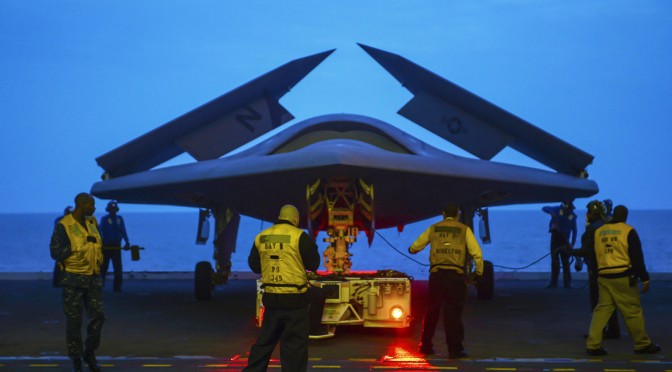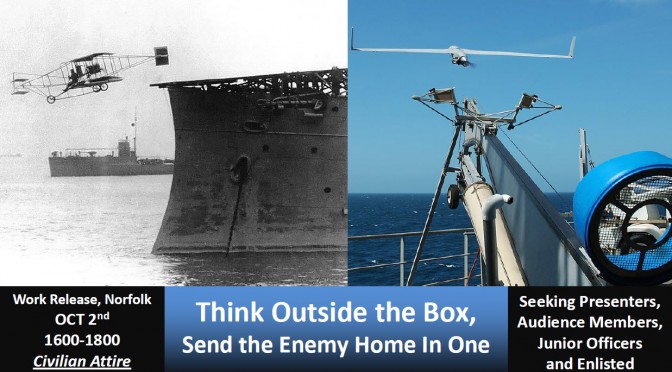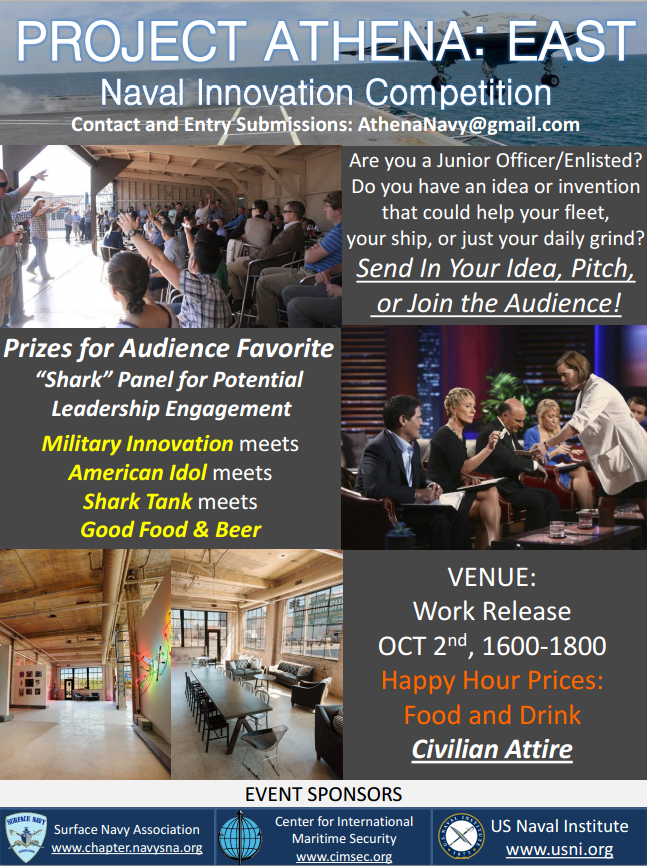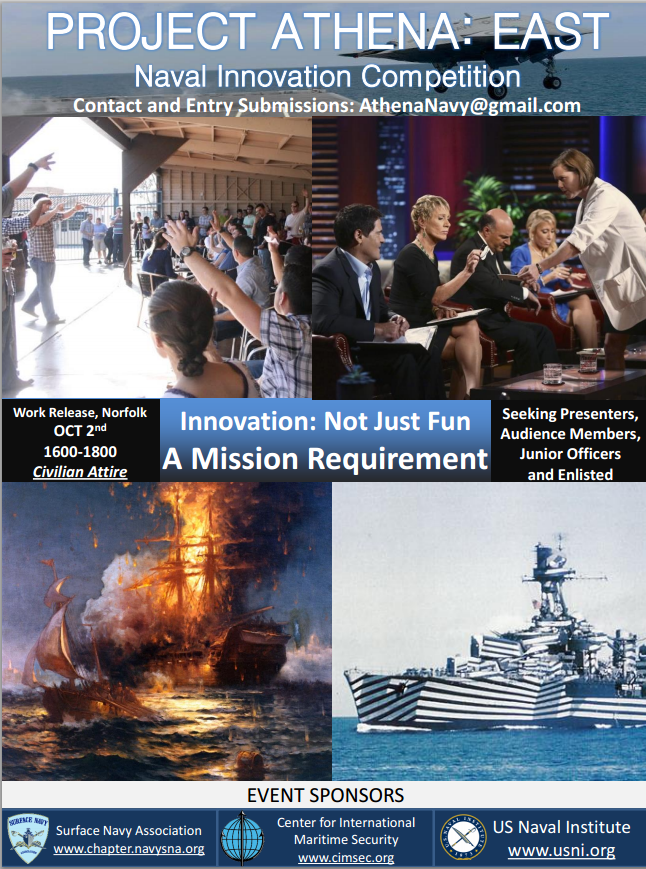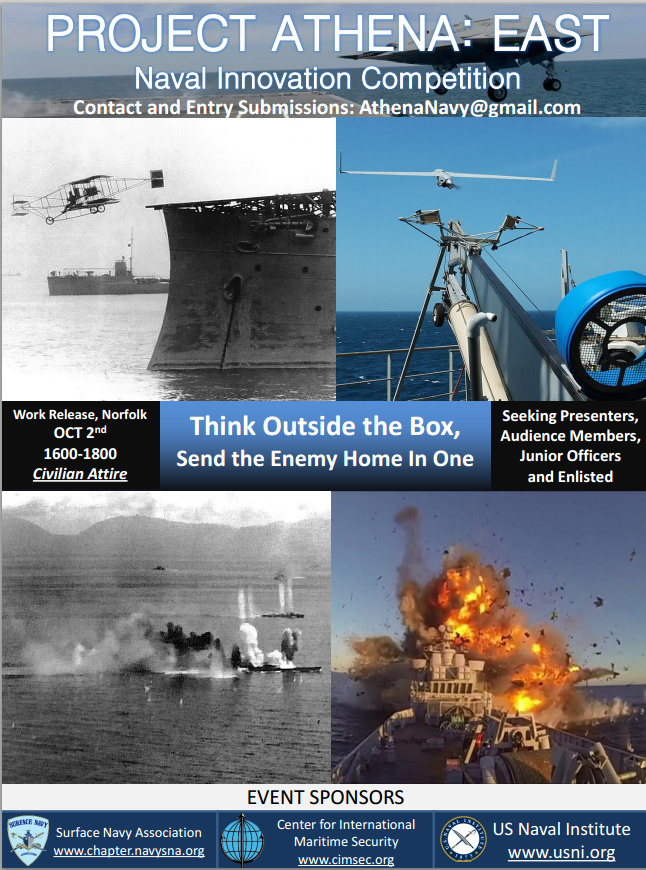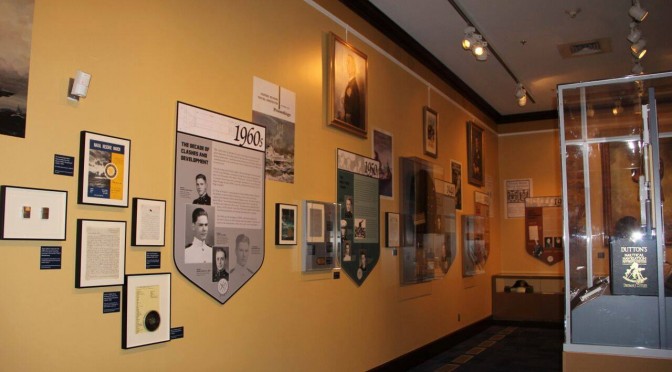By LT Jon Paris
It was Day 43 of the war everyone said would never happen: The war that assured mutual ruin and held little tangible benefit for either side. Yet, here he was, hurtling through the sky in the pitch black nothingness of the western Philippine Sea in mind-numbing turbulence and a driving rain. One wouldn’t think that silence would be possible with the rain and the wind and the two howling General Electrics back aft, but it was silent. Eerily so. Lieutenant “Slider” Wilmore pondered this reality as he checked his instruments and reflected on the air wing’s losses to date. They were not catastrophic, to be sure, but for a man on his third cruise, they were more than he had ever seen. They were also the first of his career that were credited to the enemy, rather than pilot error or malfunctions.
In this command and control denied environment with no GPS or voice communications, the challenge of getting the force from the Boat to the beach and back was infinitely exasperated. The Navy quickly innovated, the industrial base responded swiftly, and “bullseye” became a tangible object. The Navy thus required its ship drivers and pilots to execute precise maneuvers based on pre-planned maritime trigonometry and dead-reckoning. The concept was on the fringes, it had obvious weaknesses, but it was all they had.
These thoughts – and many others – flickered through his brain like an insomniac flips through the channels of late-night TV. He snapped out of it when his newly-installed, low-tech WRN-100X waypoint tracker flashed three times, though. He sighed, looked down into the inky nothingness, took a deep breath, and hoped that his dead-reckoning had been correct. No Carrier Control Area, no GPS, no TACAN, no nothing, as far as he was concerned. All he had was another example of futuristic low-tech; a lonely, beeping ALQ-80 Self-Correcting Bullseye Buoy bobbing in the middle of nowhere, launched that day by the submarine CHICAGO. With this on his mind, he flipped down his night vision goggles, rolled his Rhino to port and pulled back hard. He was either in the Break, or he was bleeding speed over a watery grave – there was no way to be sure. His radios were silent, of course, as they had been for weeks. He slapped down his flaps, then his gear. After steadying up, he lowered his tailhook, eased off the power, and prayed that this blind-man’s waltz would guide him to the Groove. No lights were visible – anywhere. Up until recently, this type of recovery – bastardized as it was – would never have been conducted at night. The mighty enemy hackers to the west had done their number, though. They had exploited the recovery methods specifically developed for just this type of denied environment to devastating effect. Now, he and his mates were looking for the Boat in a slightly more advanced manner than Columbus had looked for the New World.
The sweat on his back made him shiver. There – another three flashes of his waypoint tracker, itself completely reliant upon the buoy’s ability to self-correct for currents and his own trigonometric skills conducted at 500 knots some 2 hours in the past. Another pull to port, cutting some more power. As he settled onto his final course, he saw nothing. His heart sank along with his altitude. Easy with it, easy with it. The mantra pulsed through his brain. Then, rising and falling with the swells, he made out the impossible – a slightly blacker spot than the surrounding abyss. He puckered tight and squinted, just as a Chem-Light was broken and hurled into the middle of the blackness. He aimed for that spot and nearly closed his eyes as he sunk lower and lower towards the endless depths. CRASH! Though the sudden deceleration was welcome and expected, it never ceased to take his breath away. He retarded the throttles, raised his hook, and followed the ghostly Yellow Shirts across the lightless deck. Lieutenant Wilmore, soaked, jittery and tired, had not killed anyone tonight, for that was not his mission. The two jet-black ALQ-X99 pods under the wings were his mission and, many thought, the U.S. Navy’s only hope.
LT Wilmore sized up his surroundings. He was in “Oz” – Flag Country. Not a Lieutenant’s favorite place to be and certain to cause any junior officer additional anxiety – something he did not need as he stood there still trembling from his mission, cold in dripping flight suit. His CO stood in front of him and gave him a reassuring nod. He knocked and they both entered the space together.
The two aviators found themselves surrounded by the Strike Group Commander, Rear Admiral Patrick Aiken and his staff. “Have a seat,” the admiral said after shaking the junior pilot’s hand. “Let us cut-to-the-chase. How did they respond to the ALQ-X99? Did they fall for it? We only lost two tonight so you must have had a pretty hairy time up there. Iron Hand… I never thought we would bring it back. Are you alright? Tell me what you saw.” The admiral spit out his comments rapid-fire as Lieutenant Wilmore sat there in a daze, thinking about his special cargo and of the terror he had felt only hours ago. He slowly blinked.
The adversary had the U.S. Navy in a corner. Their coastal defenses seemed impenetrable, extended out hundreds of miles, and appeared to have an endless inventory. They had more aircraft in theater than the Americans and were not afraid to lose a handful in pursuit of big gains. Their surface ships had been hit hard, but their submarines still roamed the seas hunting for targets. And their surveillance was top-notch. The U.S. Navy had to do its best to remain invisible while at the same time, launching highly-technical and heavily-laden Alpha Strikes from extreme ranges to hit both coastal and inland targets. Winning the war depended on the Navy’s success. Unfortunately, this meant facing an angry swarm of fighter and attack aircraft, as well as a blinding throng of missiles reaching out like tentacles for F/A-18s, destroyers, and carriers, alike. While the enemy’s inventory was deep and their supply lines were well-defended, no force could keep up their blistering pace of sorties and missile launches without the occasional pause for reloading, re-targeting, maintenance, and rest.
Operation Iron Hand was a Suppression of Enemy Air Defenses mission-set executed by both the Navy and Air Force during Vietnam. It focused on localizing Surface-to-Air gun and missile radars ahead of the strike package and then neutralizing the threats with anti-radiation missiles before they could cause the friendly formations harm. In today’s war, localizing was less of a problem. The enemy was not being shy about using radars or their associated weapons, not to mention the fact that most of the launchers, and of course the ground-based aircraft, were mobile. The Navy quickly realized that this was no Vietnam and that there would be no sneaking in to exploit the enemy’s thirst for a kill prior to overwhelming them with a strike-force. The Hail-Mary solution had actually come from one of the most heart-pounding chapters of naval fiction ever to grace a Tom Clancy novel. “Dance of the Vampires” depicted a Soviet strike on a U.S. Carrier Battle Group. The strike was unique in that the Soviets led off with a massive launch of drones, duping the Americans into committing most of its anti-air missiles and its interceptors and leaving it nearly defenseless once the barrage of anti-ship missiles was loosed. Though modern surface-borne electronic decoys were nothing new, they were vulnerable to submarine attack, had limited capabilities, and did nothing to address a deceptive air battle – relatively useless in this scenario.
The ALQ-X99 attempted to solve this. It used extremely realistic electronic decoys – blips on the enemy radar – absorbed existing radar cross sections, and utilized a form of parallax to show a massive ghost-force that was sufficiently off-set from the aircraft carrying the pods. A number of F/A-18s now flew on the deck and carried these pods to the front, attempting to draw the enemy to a fight that did not exist while allowing strike packages to attack when the enemy was either exhausted or otherwise focused. Though the ploy was easy enough for the enemy to decipher after repeated use, they could not afford to ignore it. Thus, Naval Aviators like LT Wilmore were left to keep their critical packages intact, stay alive, and truly feel the mental exhaustion and strain of today’s Operation Iron Hand II.
His blink seemed to last a year. He snapped to. “I did what I had to do to stay alive, sir. Missiles exploded to my left and right. The bad guys were everywhere. They ate it up. The Alpha Strike got through. The ALQ-X99 works, sir, but I don’t know if I’ll ever stop shaking.”
LT Jon Paris is a Surface Warfare Officer and Department Head. He has served aboard three Aegis ships in the Western Pacific and Middle East.
This article featured as a part of CIMSEC’s September 2015 topic week, The Future of Naval Aviation. You can access the topic week’s articles here.


